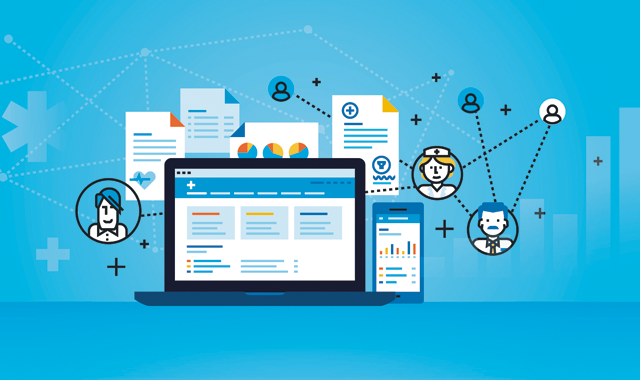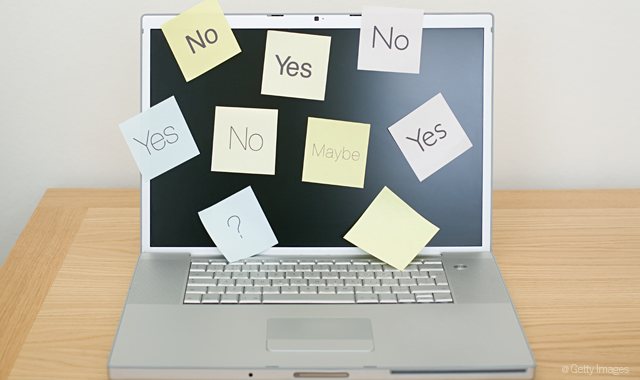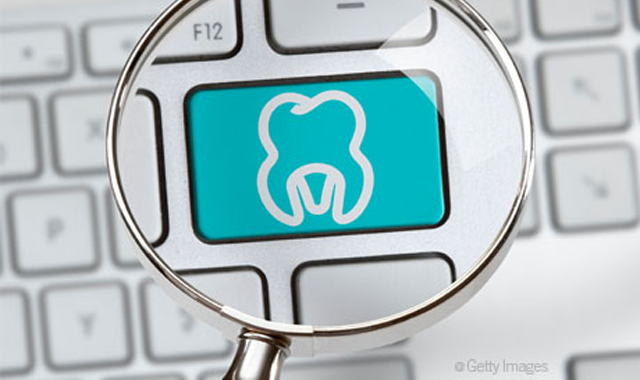9 Questions to Ask About EHR
Should your practice enter the world of EHR? You should consider these things before you take the plunge.
While electronic health records (EHRs) are widely used in medicine, it hasn’t quite taken off in dentistry. Some experts, like Mike Uretz, executive director of DentalSoftwareAdvisor.com and dental software advisor for Dental Products Report, tout the advantages and inevitability of EHRs in dentistry, while others aren’t quite so sure. Dr. Lorne Lavine, founder and president of Dental Technology Consultants, had once advocated for dental practices to invest in EHRs but is no longer a proponent. Now that the meaningful use incentive is no longer available, there’s just no real reason to invest, he says.
“When the funding was available and the office qualified [for the incentive], we absolutely advised [investing in an EHR], because that was a significant amount of money available to them,” Dr. Lavine says. “That opportunity is now gone, so we are not currently pushing EHR as an option. Most dental practices use maybe 5-10 percent of what their dental practice management software can do. They use it for patient information, scheduling, billing, treatment planning, charting and that’s kind of it. The things that you would normally get in a full-feature EHR module, the vast majority of offices don’t need or want.”
And for “most” offices, he’s talking probably 98 percent of them.
“I would say that, of the offices we’ve worked with, the number of those using an EHR module is between 1-2 percent,” Dr. Lavine says.
Related reading: What dental professionals need to know about the EHR incentive payment program
Uretz disagrees with this assessment, mentioning that although having eligibility for the incentive was a nice perk for a small amount of eligible offices, there are many patient care, operational and workflow reasons to obtain EHR. “There are [also] five more years available for Meaningful Use subsidies for qualified offices,” Uretz says. “In fact, I’m helping a number of practices and groups get substantial year two Meaningful Use incentives [this year] and will continue to help them obtain funds through the end of the program in 2021.”
Plus, one reason that some dental practices might not have pursued EHR in the past is because of their business model. In that case, Dr. Lavine believes the future could bring about a greater increase of EHR use in dentistry as the dominant model swings from private practice to DSOs.
And with the number of third-party systems that integrate with practice management software, electronic health records seem unnecessary, he says. “EHR is supposed to take a bunch of disconnected systems and have them work together, but in dental, we don’t see as much of that,” Dr. Lavine says. “It doesn’t have the traction in dental that it does in the medical field.”
Trending article: Are DSOs really taking over?
But perhaps that will change as the industry evolves.
“Each year, the systems get better and better,” Uretz says. “Over the last three years, more software vendors have recognized the importance and hopped on board. The growth of multi-location groups has really accelerated EHR development. With groups, there are more locations and more dentists, and it’s important to standardize the patient care and manage what’s going on clinically. So that’s pushing more vendors to look at electronic health records.”
So should your practice take the leap into the world of EHRs? To help you decide, here are nine questions you should ask when considering whether electronic health records are right for your practice.

1. “Should I get an EHR that works with my practice management software, or get one system that has both components?”
If you decide that an EHR is right for your practice, you’ll need to decide if you’re going to invest in a separate system that can interact with your current practice management system, or if you’re going to invest in a system that has both.
“The better way to do it is to get a vendor that has both in one system so that it’s not two different systems talking to each other, it’s actually tied in together,” Uretz says. “You want that information integrated into one piece of software in one database.”
Trending article: Why practice management systems are crucial
“Normally, it’s less trauma to get something that directly integrates with the practice management software,” Dr. Lavine says. “Most of the major players have an EHR module that’s designed to work with their [practice management] software. It typically costs a little more than going with a third party, but you don’t have to deal with any of the integration issues. If all else were equal, I would say go with something that’s provided by the practice management company, unless they just can’t provide the functionality that you’re looking for.”
Going with a third-party system may save costs up front, but it won’t make financial sense in the long run.
“The downside of investing in a separate EHR system that claims to communicate with your present practice management system is that you’ll likely be doing a lot of double entry and you might eventually lose integration,” Uretz says. “Though they might work together in the beginning, there can eventually be a change on one side that will create a disconnect between the two, and integration will stop working. Or a company might decide they want both sides of the business and won’t allow interfacing. Most of the time when I’ve seen a practice do it this way, this is the inevitable result.”

2. “Is the software intuitive enough for me to actually use it every day?”
Approaching EHR software requires the same considerations as any other software, says Uretz.
“Delve deeply into the technology,” he says. “Is the system scalable? In other words, is it built on old technology that will be outmoded in two years? How’s the security? Will it interface with web portals?”
Trending article: How EHRs can improve your dental practice
He advises having a technical person look into those specifications so they can ask those kinds of questions.
“It’s important when you look at EHRs to not just look at what you see on the screen, but also the underlying technology,” he says. “How does it interface with other third-party clinical software, like imaging? Can it interface with imaging in the cloud? Can it interface with different devices?”
Uretz also advises making sure it will interface with other clinical procedures in the practice, like taking blood pressure. “More dental providers are taking vitals such as blood pressure,” he notes. “So the question is if the EHR system will automatically interface with data from devices such as blood pressure cuffs in other monitoring machines. Or for another example, in the case of oral surgeons, are there possible interfaces between anesthesia monitoring devices and the EHR?”
Trending article: The benefits of EHR in group practice
And finally, make sure that the system is ideal for both the practice management and clinical sides. “The clinical people and the practice management people both have to like it,” Uretz says.
“Ease of use is probably the most important thing,” Dr. Lavine says. “The fact is that any system that has something unique will be copied by everyone else within a matter of months. But being able to learn and use the software is critical. My recommendation for offices is to get demos and involve their staff with it. At the end of the day, if the program is not intuitive, it doesn’t make a difference what features it has because you’re never going to use those.”

3. “Does the system have structured data?”
Electronic health records are about more than just creating a paperless practice: it’s about using patient data more effectively.
“In dentistry, we are getting to the point where we can input data into the computer and do something with it,” Uretz says. “When a dentist does an exam or procedure, they can take that information and put it into a database. It’s searchable, so you can pull up critical information at any point on patients and procedures for many uses, including clinical decision making. It’s called ‘structured data’-the ability to enter clinical information about patients in a structured format and save it to a database so it can be used later.”
Trending article: How dental EHRs can streamline referral processes
Structured data provides additional benefits to group practices as well.
“There are many ways for dentists to do exams and procedures, which could potentially be a problem when it comes to managing group practices,” Uretz says. “So a benefit is having the ability to standardize care throughout the group and locations. Especially for new doctors coming out of dental school and going into a group practice, it’s a great way to make sure everyone is on the same page. It helps create efficiency in patient care.”

4. “Will this system simplify accountable care?”
“If you talk to dental insurance companies, you’ll find out they are moving toward accountable care, which has already been embraced in medicine,” Uretz says. “The idea of adding diagnosis codes along with procedure codes is essential to an accountable care model and is on the near horizon in dentistry. As the sheer volume of codes grows, it will be virtually impossible to manage without the use of electronic health records.
Trending article: 6 myths and facts about electronic health records
On the other hand, Dr. Lavine doesn’t think accountable care necessitates EHRs.
“Most dentists are using e-claims already, where the software can check for the validity of the claim right away and determine whether support documentation is needed,” he says.

5. “What impact will the system have on clinical decision support?”
“Through informatics efforts, there is a growing amount of information regarding oral health best practices,” Uretz says. “Suggested ways of handling cases comes out of clinical evidence and research. An EHR can give you information based on research on how you might handle the problem.
Trending article: 3 important ways to protect your patient information
"The benefit of that is that no dentist or hygienist can keep up with all of the research being done, so having a tool that can offer clinical decision-making support helps providers make intelligent decisions about their patients based on evidence and information in the database. Providers aren’t required to follow guidelines presented, but it is helpful to have evidence-based information at your fingertips while you are making decisions.”

6. “Will having an EHR make my practice more efficient?”
It certainly can, if you utilize all it has to offer. From streamlining information entry, offering electronic prescriptions and patient images, and automating patient recall, EHRs have the tools to optimize your workflow.
“Because, in many cases, billing information is manually entered into the practice management system after the patient clinical encounter, it’s not a streamlined process and can be prone to errors,” Uretz says. “With EHRs, [practices] have the ability to enter this information at the point of care when the work is performed and thus electronically move through the claims process without any double entry. In many cases that allows practices to be paid faster and prevents mistakes.”
More from Mike Uretz: State technology subsidies: Dentistry's best-kept secret
Electronic prescriptions offer more than convenience, says Uretz. “When you have a patient in the chair and need to prescribe medicine, you can push a button and get the information you need: all the meds a patient has been prescribed, whether from a hospital, primary care physician, nursing home or other provider,” he says.
“Instead of the patient having to remember all of their medications, you have that information at your fingertips. You also have access to the contraindications. So, for example, if you prescribe a pain med, you’ll see if there is a potential interaction with other medications they’re on or with their allergies, which is good for patient care and especially helpful from a liability perspective. You’ll also see how they might tie in to dental conditions. It might say that certain drugs you are prescribing might cause dry mouth, for instance. And some systems allow you to see real-time formulary insurance coverage, so you know if you should prescribe a generic version or another drug. You’ll know before the patient leaves the chair if the prescription is covered by their insurance.”
Trending article: 25 ways practice management software can save you money
In addition, having access to patient images in the software means no more switching systems. “If you’re doing a procedure or diagnosis and you want to see an image from a few months ago, you can have access to it without having to switch to the imaging software,” Uretz says.
Finally, they offer automated recall. “If you have a patient visit and a follow-up is needed based on clinical rules you have put into the EHR, the system automatically can push out recalls in a number of ways to the patient, including the patient portal,” says Uretz. “That’s important because if you miss a potential recall, that’s business lost. Also, the next time a patient calls or comes in for a visit, the care team will be aware of any medical or dental alerts.”

7. “Will the system improve patient education?”
You’ll also want to check and see how user-friendly the system is in regards to patient education. Ideally, EHRs should help increase your case acceptance by improving the patient’s clinical experience and helping them understand treatment options.
Trending article: Why dentists need to engage in discussions about periodontal disease
“Previous to EHRs, you’d typically print out something for the patient to take home,” Uretz says. “EHRs will recognize details in the patient’s care while they’re in the chair, and with the push of a button, it’ll bring up an image or a video. If you have a tablet or a screen in front of the patient, you can show them in real time what you’re talking about. That’s powerful in helping the patient understand the procedure and agree that it’s necessary. If they don’t understand it, they’re not going to accept those cases. Some systems actually push patient education information to the portal as well. That allows you to interact more with the patient.”

8. “Does the system offer electronic referrals?”
EHRs can act as a patient tracking system if they enable electronic referrals, Uretz says.
“The traditional process is a long workflow, and you don’t get confirmation when the patient goes to the specialist that you referred them to,” he says. “With EHRs, you have the ability to refer that patient out from the point of care. It is sort of like a UPS tracking system: It’ll send the referral to the specialist, and when the specialist works on the patient, it could potentially send that information back to the patient’s record in your practice. So there’s an electronic footprint of the patient going through the referral system back to you, and all the information is in the system.”

9. “Will the system help build a medical home for my patients?”
With the rise of education on the oral-systemic connection, the push for health care providers from all specialties to communicate with each other is getting stronger. Being able to share data with all of your patient’s providers is an essential benefit of electronic health records.
The patient’s providers sharing information to better treat their patient’s whole body health is called the medical home, and it’s important to make it more efficient, says Uretz.
More from Uretz: How to negotiate your EHR deal
“You do that by enabling each of the health care providers to communicate in the patient’s health record,” he says. “That way, each provider has a full picture of what’s been done on the patient, and they can make decisions based on a full picture of the patient’s health, and not just what that particular specialist is seeing. Dentistry is being brought into that more now that we know more about the oral-systemic connection. The only way to do that electronically is with proper electronic health records. In the future, the goal is to have all of those providers be able to share information and we are getting closer to this objective. As we progress with dental EHR technology, some of the more innovative dental software vendors are prescribing to the patient record interoperability standard, which has already been fully embraced by medical software vendors”
But that may be more of a benefit in the medical field than in dental, says Dr. Lavine.
“One of the main hallmarks of EHR products, at least in the medical field, is interoperability: the ability to exchange information with other providers and software products,” Dr. Lavine says. “We don’t have that in dentistry. It’s controlled by a few major players who all have their own proprietary products, so there’s no easy way to exchange patient information. A Dentrix user can’t exchange information with an Eaglesoft or a Softdent user. The whole purpose of EHR was to make it easier for health care providers to share information, but that’s not the case in dental from my experience.”